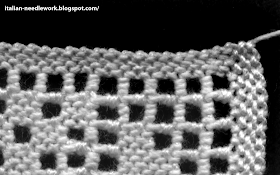When you get to the top and do your last two stitches in the last hole, continue on and join the selvedges with two more rows of two stitches, this time hooking into the stitches of the previous selvedge as shown below:
 |
| Second-to-last row. |
 |
| Last row, return to the extreme right edge. |
 |
| Turning the work back 90 degrees, it looks like this. |
Or, you can finish the edge as you would if you were going to insert your snowflake into a piece of fabric. This makes a nice lacy edge even if you're not inserting it. Doing the edging also hides imperfections in your selvedges and somehow stretches the piece out and back to square if it has become warped in the stitching process.
To add the edging, we're going to continue on with the thread from where we left off at the corner.
The outer lacey edging is just like making the small holes as we did in the first and last rows of our design. Skip one stitch and insert your needle into the next, leaving a bit of a loop do a hooking on stitch and two return stitches to form a column. Continue on to the end of the row. For this design, you should end up with 17 loops (or small holes) because we have 34 stitches along the edge and we're putting a column in every second stitch. I turned the work so that my stitching is along the top, I find it easier to work this way.
 |
| Here we are at the end of the first edge with 17 loops or small holes. |
Continue on in the same manner as before and make 17 loops or small holes along each edge until you meet up to where you began:
Here you will need to insert the needle into the same stitch as the previous column so that you can form the corner loop. Do your hooking on stitch taking care to make your corner loop the same size as the others. Then take your needle behind both vertical threads and do two return stitches to form a single column. You end up with your needle and thread in front of your stitching instead of behind it where you normally would be. Pass the needle through the corner loop to take your thread to the back.
Here we are, all finished our Puncetto Snowflake!
I soaked mine overnight in some Marsiglia soap (as it's called in Italian) to whiten it back up. I had a few blood stains to get rid of for which the best remedy is your own spit - no really! It works like a charm. Then I ironed my snowflake face down on a towel. To finish my thread ends, I just did a really small stitch on the back with both thread ends on either corner and trimmed the excess thread.
I'd love to hear from you if you found this a useful exercise, and even if you did not, please post below!






It's amazing to think that with a needle and some thread one can make something so beautiful! I have enjoyed seeing your progress on the snowflake. :)
ReplyDeleteThanks so much for all your information.
ReplyDeleteCan you tell me how to buy the best book on puncetto, please?
Posso anche leggere in Italiano.
I am writing from Dallas, TX
Alessandra,
ReplyDeleteThe best book "A Scuola di Puncetto Valsesiano" is presently out of print with some permission problems blocking the reprint. I'm afraid I don't know who has this book for sale as it was hard to find before this little roadblock. You could try emailing the ladies who wrote it but they are not terribly reliable at answering emails. If you can write in Italian, you might have a better chance at a reply.
puncetto@libero.it
You might have a better time getting your hands on an old copy of the Anchor Manual of Needlework which is not as good but perhaps easier to find.
Good Luck!
stupendo
ReplyDeletegrazie per aver pubblicato questo tutorial
spero ce ne sia un'altro, prestissimo
baci e buone feste
Hai Imparato molto bene a Parma, ed io con le tue spiegazioni, ho provato a fare il tuo lavoro, non è venuto molto bene, ma spero di migliorare. Com'è piccolo il mondo con internet, tanto da far viaggiare le nostre esperienze tra tutte le amanti di ago, filo, fuselli ecc. Spero di poterti incontrare presto. Un abbraccio
ReplyDeleteGabriella Mantellassi
muchas gracias jeanine,tu explicación de tu experiencia para resolver los problemas fueron muy útiles agradezco tu amabilidad al publicarlos ,saludos maria
ReplyDelete